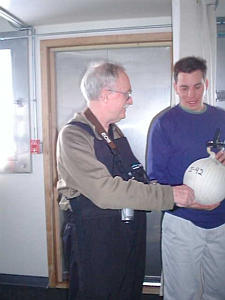17 January, 1999
Sunday, January 17th, 1999
Good Morning to every body in the North ---
What a glorious day it is again here at the South Pole. It is a very
special day: 87 years ago, on January 17th, 1912. R Scott arrived
here. As I walked over to the geographic pole, as I do almost every
day, I read his words again: "The Pole.Yes, but under very different
circumstances from those expected." He must have been so disappointed
not being the first at the pole. Even though no one in his group
survived, they did accomplish a lot of important things on their
expedition. When his group was found, they realized that Scott and his
men dragged about 35 pounds of geological samples back with them,
which were later analyzed. Above all, Scott's diary remains an
important historic document. He made entries up to his last hour.
Also, several parties under his direction made new discoveries in the
Antarctic. One of them was that three men became the first to collect
Emperor penguin eggs by traveling in the dark, Antarctic winter.
Another party lived on Cape Adare for a year and collected different
data.
After some contemplation about Scott, I met our NOAA group at the
'Clean Air Sector' at ARO's -- about 10am. The reporter Jack Williams
from USA-Today was going to meet us for an interview. He has been
writing for the climate and weather section for USA-Today for a long
time. He called me once while I was still in New York and we emailed
to each other several times --- so, I was looking forward meeting him
in person. We explained to him all of the research done by NOAA (see
also journal entry 01/14). He will also join us tomorrow at the BIF
for one of our triple ozonesonde balloon launching.
I have introduced many aspects of science here at the South Pole and I
always wondered how the research all started here at this continent
and parcticular at the South Pole. I looked through some booklets and
talked to some people to find out.
After Roald Amundsen and Captain Robert Falcon Scott's expeditions to
the South Pole in 1911 and 1912 the South Pole was not visited again
until October 31,1956. On that day, a ski -equipped aircraft (R-4D)
landed at the Pole. On board were Admiral George Dufek and several
other personnel of the United States Navy. Their purpose was to survey
the site in preparation for the International Geophysical Year (IGY),
to be held 1957. The Construction of the original South Pole Station
began the following month and by February 1957, the station was
complete. An eighteen man Navy support and civilian science crew, led
by John Tuck and Paul Siple remained for the winter, the first of the
winter-over parties that have continuously occupied what became known
as Amundsen-Scott South Pole Station. The original station was
modified and expanded over the years, but by 1967 it was becoming
increasingly apparent that a new station would be needed.
The construction of the current South Pole Station began during the
1970/71 austral summer. The Erection of the dome, arches and interior
structures took place over the next three summers. The finishing work
was conducted during the 1974/75 season, and in January, 1975, the
station was formally dedicated. The old station was abandoned and
winter operations commenced at the new facility the following month.
Almost 25 years later, the present station has become too small as
well and is also being buried by the snow. The construction of a new
station is on the way. Including the Jamesway facilities outside the
dome, the summer population is limited to 200 per night. With the
amount of science and the construction projects, the South Pole is a
very busy place during the summer. The demanding pace is necessary to
allow a large number of people to accomplish their work during the
season. After the hectic summer season, the winter population will
settle down to 45 people --- the largest number of people ever
wintering-over at the South Pole because of the construction of the
new South Pole Station. I wonder what it would be like to winter-over
here with the last plane leaving late February and the first plane
arriving in October with computers as the only connection to the
outside world. !
More emailing and a science lecture at night, a walk… and snail -MAIL
for me! What a warming touch by friends. One quesitonwas: how long
does mail take to get here and how is it delivered? 1:30 am again.
Tomorrow will be another ballooning day. Talk to you soon…

USA-Today reporter Jack Williams is visiting ARO. Joel is showing him one of the flasks in which he collects air samples to test for carbon dioxide.
Contact the TEA in the field at
.
If you cannot connect through your browser, copy the
TEA's e-mail address in the "To:" line of
your favorite e-mail package.
|
